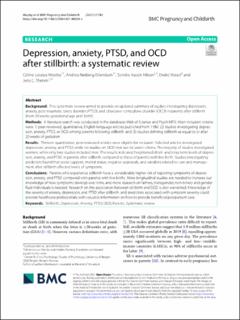| dc.description.abstract | Background: This systematic review aimed to provide an updated summary of studies investigating depression, anxiety, post-traumatic stress disorder (PTSD), and obsessive-compulsive disorder (OCD) in parents after stillbirth (from 20 weeks gestational age until birth).
Methods: A literature search was conducted in the databases Web of Science and PsychINFO. Main inclusion criteria were 1) peer-reviewed, quantitative, English-language articles published from 1980; (2) studies investigating depression, anxiety, PTSD, or OCD among parents following stillbirth; and (3) studies defining stillbirth as equal to or after 20 weeks of gestation.
Results: Thirteen quantitative, peer-reviewed articles were eligible for inclusion. Selected articles investigated depression, anxiety, and PTSD, while no studies on OCD met our inclusion criteria. The majority of studies investigated women, while only two studies included men. The results indicated heightened short- and long-term levels of depression, anxiety, and PTSD in parents after stillbirth compared to those of parents with live birth. Studies investigating predictors found that social support, marital status, negative appraisals, and variables related to care and management after stillbirth affected levels of symptoms.
Conclusions: Parents who experience stillbirth have a considerably higher risk of reporting symptoms of depression, anxiety, and PTSD compared with parents with live births. More longitudinal studies are needed to increase our knowledge of how symptoms develop over time, and more research on fathers, transgender, non-binary and gender fluid individuals is needed. Research on the association between stillbirth and OCD is also warranted. Knowledge of the severity of anxiety, depression, and PTSD after stillbirth, and predictors associated with symptom severity could provide healthcare professionals with valuable information on how to provide beneficial postpartum care. | en_US |

